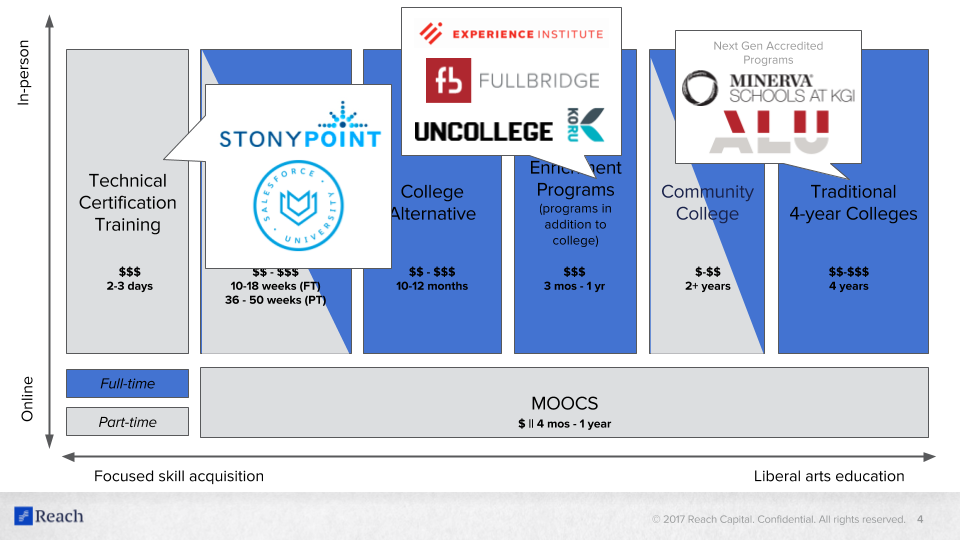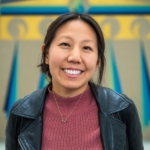by Chian Gong
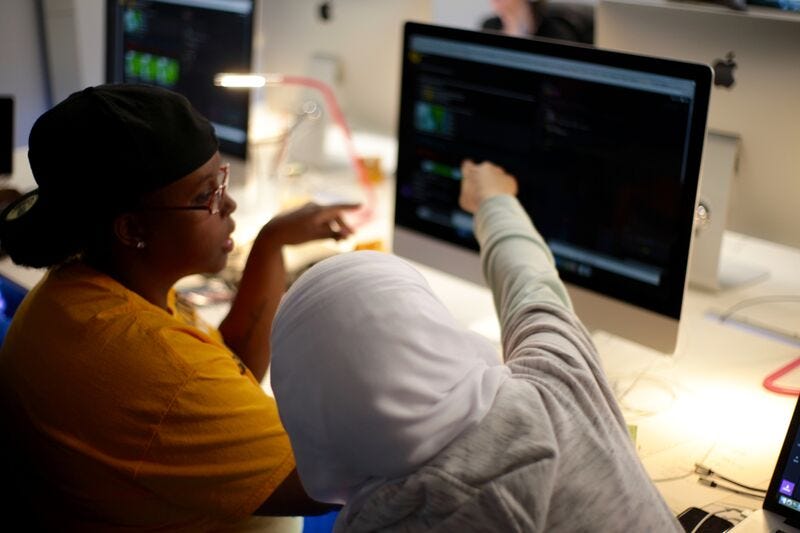

Origins
Reach’s interest in the post-secondary market emerged in response to a growing inbound pipeline of boot camps and college alternatives. We were excited to meet founders of schools like Holberton School, MissionU, and Learners Guild and saw rapid growth in the focused skill acquisition space with companies like DevBootcamp, Hack Reactor, and Galvanize. Perhaps most importantly, we were intrigued by the potential impact that such new programs could have on students and their access to economic opportunity.
While the value of a college degree has long been established (on average students with a college degree earn $43,000 versus just $25,000 for those with a high school diploma) there are still significant barriers to college completion, particularly for first generation students. Nearly a third of all first-generation college students drop out within 3 years of enrolling, and are left with student debt and no college degree. While there are a growing number of solutions to help students succeed in traditional colleges, new educational options have emerged that provide compelling alternatives to college.
Programs like Holberton School and MissionU are embarking on a paradigm shift. They offer a new path for three different types of students:
- new high school grads exploring two and four-year college programs (skilling),
- career switchers considering a ‘bootcamp’ model (reskilling), and
- career advancers looking to build new skills to get to the next level (upskilling).
This market mapping exercise was an attempt to examine the landscape for each of these archetypes.
Organizing principles
In defining “college alternatives” we zoomed out to identify the different education opportunities an individual might evaluate when looking to continue their education after high school. The myriad options are varied and exist along a spectrum from targeted skill workshops to advance a student’s current career to more holistic programs for students to continue their education more broadly in preparation for the job market. We then categorized these programs on the continuum of program breadth (targeted skill acquisition vs. liberal arts education) as well as online vs. offline. From here, we established seven broad categories.
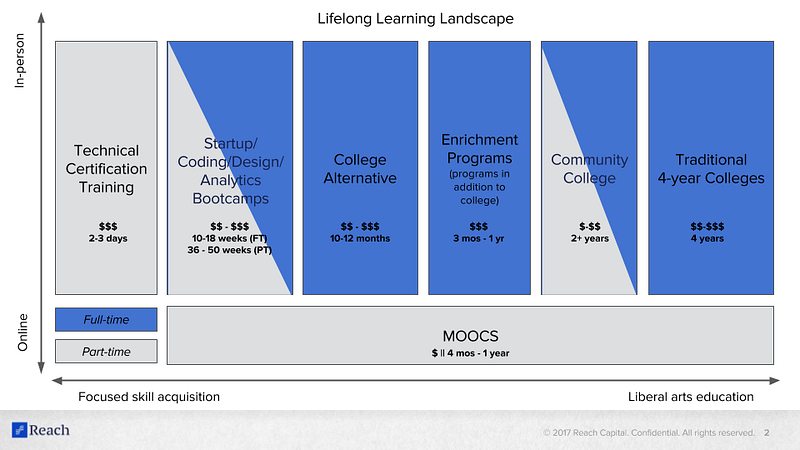
Technical Certification Training
The most vocationally focused programs are technical certification trainings which tend to cost several thousand dollars for a multi-day workshop that yields a credential of some kind. These programs are available both in-person and online and yield credentials such as Salesforce Administrator certification or Chartered Financial Analyst (CFA) levels I — III. Most commonly, these trainings are sponsored and encouraged by a student’s current employer and are focused on ‘upskilling.’
Traditional Four-Year and Community Colleges
Currently, the most common path for high school graduates is to enroll in traditional two or four-year programs in established brick and mortar colleges and universities. With 2–4 year commitments and thousands of dollars in tuition, outcomes are varied. While graduates of top universities generally receive a strong response from the workforce, community college students typically travel one of two pathways: transferring to a four-year program or receiving an associate’s degree and/or trade skills. In the past few years, innovators in the form of online or hybrid universities have emerged, including programs like Minerva.
Enrichment Programs
Interestingly, enrichment programs emerged as a reaction to the traditional four-year university. Critics felt university programs lacked real-world relevancy and sought ways to supplement the college curriculum with professional experiences and global perspectives through programs like Experience Institute, Fullbridge, and Uncollege. Oftentimes these come in the form of a gap year or a summer program and are equivalent to the cost of a semester or year of college tuition, targeting a more affluent student population.
Massively Open Online Courses (MOOCs)
When MOOCs first emerged they were hailed as the edtech disrupter of higher education, but based on today’s data MOOCs are not so much a replacement for higher education as a flexible and low-cost way for college educated individuals to re-skill or upskill. The model offers online courses taught by professors or industry experts that are available asynchronously. MOOCs cover topics ranging from coding to art history and span from K-12 through lifelong learning. Given the online, on-demand model, MOOCs tend to be relatively inexpensive, but also struggle with user retention and completion rates. MOOCs are now evolving into more directed course pathways (e.g. specializations or certifications) with specific skill and career objectives to drive engagement.

Bootcamps
Since 2012, bootcamps have grown 10x, with an estimated 22K+ graduates in 2017. These bootcamps cost an average of $11,400 for a ~14 week intensive course that prepares students for entry-level software development roles, oftentimes reskilling liberal arts college graduates for technical roles. Some programs also offer greater depth on specific development languages as a means of upskilling. As the market grows, we’ve seen more specialized programs based on student demographics (women, minorities, etc.) or school model (flexible vs. full-time). Bootcamps have also expanded to cover skills beyond coding such as design, sales, and product management. Alongside the growth, there have been some consolidations and closures, most notably, Dev Bootcamp will be closing its doors at the end of this year. Business model challenges drove many of these closures and bootcamps are increasingly looking to supplement their tuition revenue through corporate training or employer recruitment fees.
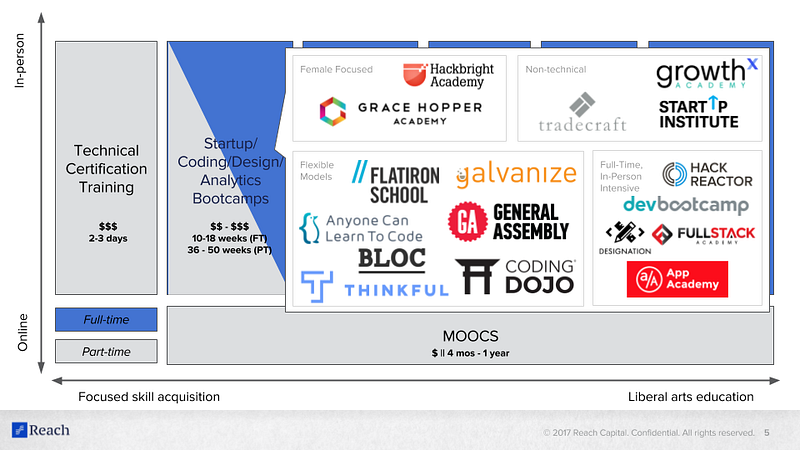
College Alternatives
While the majority of bootcamp, MOOC, and enrichment programs target continuing education or skill development for college graduates, another market segment is emerging. Programs like the Thiel Fellowship, MissionU, and Holberton School are more comprehensive and offer an alternative to college and greater depth than the bootcamp intensive model. These programs range from 1–2 years and provide a combination of deep targeted skill acquisition (software engineering, salesforce administrators, inside sales strategies) and soft skills in innovative blended and project-based models with a clear link between education and career.
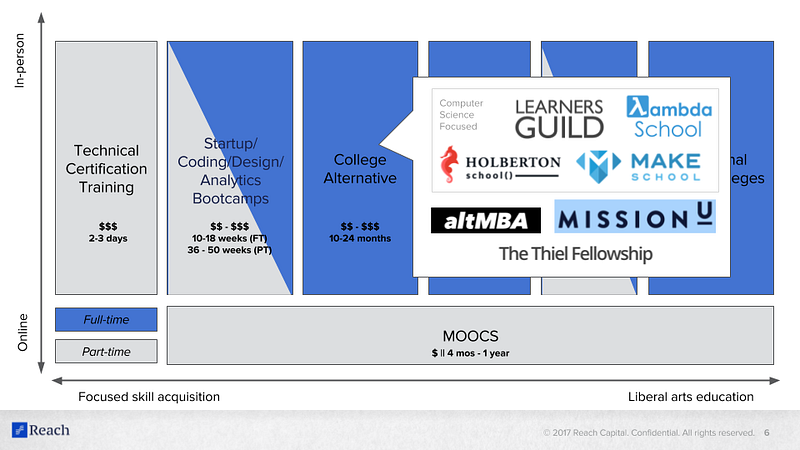
Takeaways
New post-secondary models including college alternatives, bootcamps, enrichment programs and MOOCs have been an area of interest for Reach Capital. The space is changing rapidly, but our takeaways to date include:
Drivers
- College and career accessibility: Rising student debt and the gap between college and career has created an opening for lower-cost, more targeted college alternatives
- Unmet Demand: Emphasis on software engineering and tech related skill development is driven by unmet market demand. There are over 500K computing related jobs open last year in the US, yet less than 43K students graduated with a computer science degree last year.
Business Model Innovation
- Income Share Agreements have emerged as a new revenue model for college alternative programs. This model reduces the upfront cost of school and instead contracts students to pay a percentage of their future salary for up to 3 years. This aligns incentives of the student and the school — the school only gets paid if the student is able to successfully land and thrive in their job. Additionally, it increases the eligible student pool and could potentially surface hidden talent.
- Target student differentiation as more players enter the market, college alternative programs are looking to differentiate their programs based on their target student audience whether that be by demographic (female, minority, etc.) or skills acquired (data science, software engineering, sales, design)
- Alternative monetization — more college alternatives are looking beyond students as the payers in their business model. Some programs look to monetize recruitment pipeline or to offer their services as training and professional development to be licensed to companies or even colleges.
Pedagogy
- Learning to learn college alternative programs are teasing out what elements of a college experience are critical skillsets for career success. More and more, this looks like learning to learn and the development of social emotional skills that help students land and retain a job.
- Self-directed learning many college alternative models are on-demand, online. With this paradigm shift, learning becomes much more student-directed, with students determining their schedules, goals, and time investment each week
Thank you to Jennifer Wu and Jennifer Carolan for reviewing drafts and providing feedback and a special thank you to Heejin Hahn who helped update the market map design.
*You can view the full market map here.
*Info on Reach Market Maps can be found here.

